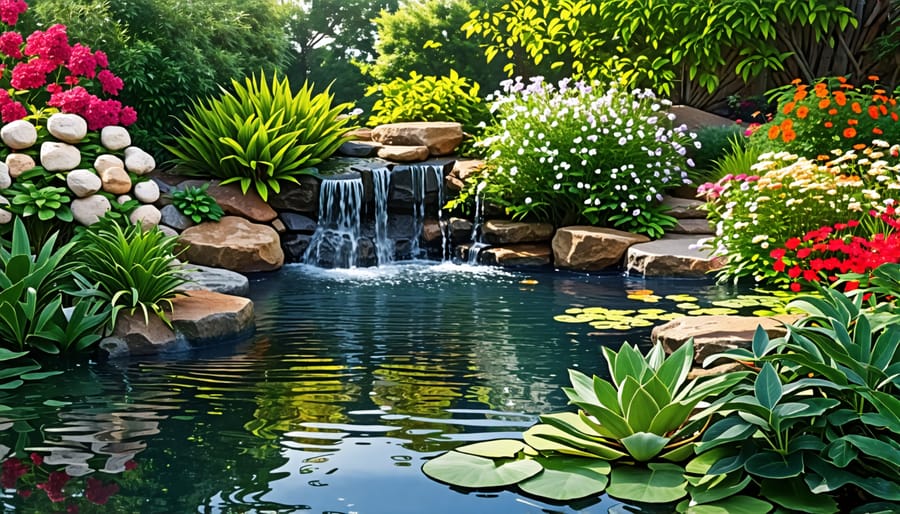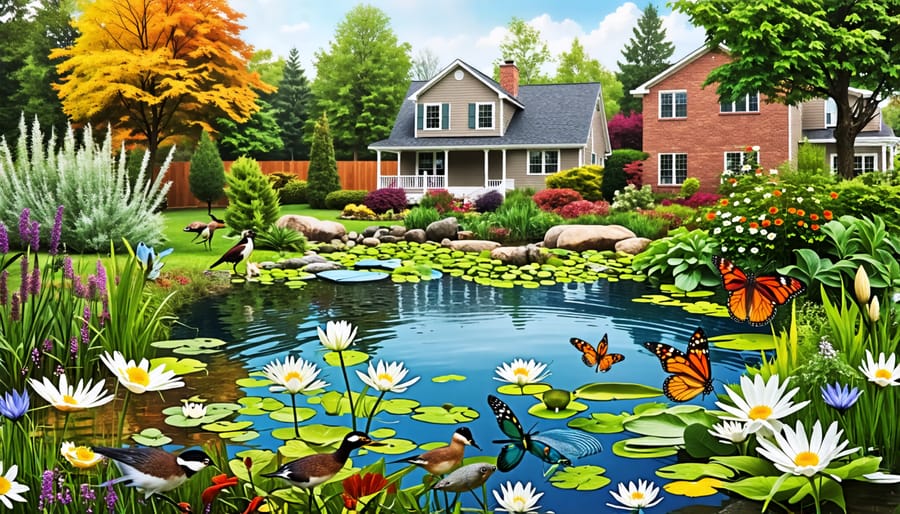
Attract Thriving Wildlife to Your Yard with a DIY Pond
Envision a tranquil oasis teeming with life right in your backyard. Building a wildlife pond creates a haven for diverse creatures while enhancing your outdoor space. With careful planning and the right techniques, crafting this mini-ecosystem is an achievable and rewarding project for nature lovers of all skill levels. From selecting the perfect location to adding finishing touches, our step-by-step guide will empower you to construct a thriving aquatic habitat that attracts a vibrant array of wildlife. Dive in and discover the joys of nurturing your own slice of natural paradise.
Planning Your Wildlife Pond

Choosing the Ideal Location
When choosing the ideal spot for your wildlife pond, consider several key factors. First, select a location that receives a good balance of sun and shade throughout the day. Too much direct sunlight can lead to excessive algae growth, while too little can hinder plant growth. Next, assess the terrain – a gentle slope is perfect for creating shallow margins that allow wildlife easy access in and out of the pond. Avoid low-lying areas prone to flooding or sites with poor drainage. Additionally, think about the pond’s proximity to your house. You’ll want it close enough to enjoy the view and the soothing sounds of water, but not so close that noise or activity disturbs the wildlife you hope to attract.
Determining the Size and Shape
When determining the size and shape of your wildlife pond, consider the available space in your yard and the desired features you want to include. Larger ponds offer more room for aquatic plants, fish, and visiting wildlife, but even a small pond can attract an array of creatures. Aim for a minimum surface area of 20 square feet, with varying depths to accommodate different plants and provide overwintering zones for frogs and other amphibians. An irregular, organic shape with curves and inlets will appear more natural than a perfect circle or square. Take into account the surrounding landscaping and create a shape that complements existing features. Use a garden hose or rope to outline potential pond shapes until you find one that fits your space and vision.
Designing for Wildlife
When designing your wildlife pond, consider elements that will attract and support a diverse array of creatures. Incorporate shallow areas along the edges, which provide perfect foraging spots for birds and easy access for small mammals and amphibians. Include hiding spots like overhanging rocks, logs, or dense vegetation where animals can seek shelter and feel secure. Choose native plants that are well-suited to your local climate and provide natural food sources for wildlife. Submerged plants like hornwort and water lilies offer oxygen and hiding places for fish and invertebrates. Marginal plants such as rushes and sedges provide perches and nesting material for birds. By thoughtfully incorporating these elements, you’ll create a thriving ecosystem that attracts a wonderful variety of wildlife to your pond, transforming it into a bustling hub of activity and a true haven for local species.
Gathering Your Materials
Here is the content for the “Gathering Your Materials” section, following the provided guidelines: Before you begin transforming your backyard into a wildlife oasis, it’s important to gather all the necessary materials. Don’t worry if you’re new to water gardening – with the right supplies and a bit of enthusiasm, you’ll have your pond up and running in no time! Start by selecting a durable pond liner that’s appropriately sized for your planned pond dimensions. EPDM rubber or PVC liners are popular choices. You’ll also need an underlay to protect the liner from rocks or roots that could cause punctures. Next, consider your filtration system. For a wildlife pond, aim for a natural balance rather than crystal clear water. A simple pump and filter setup can help maintain water quality without being too pristine. Choose an energy-efficient pump sized for your pond volume. Rocks and gravel are key for creating a natural-looking pond edge and providing spaces for beneficial bacteria to grow. Select a variety of sizes, from small pebbles to larger boulders, to create visual interest. Make sure to rinse them thoroughly before adding to your pond. Aquatic plants are the heart of a wildlife pond, offering food, shelter, and oxygenation. Choose a mix of submerged, marginal, and floating plants native to your region. Some great options include water lilies, irises, sedges, and pondweeds. Finally, don’t forget practical items like a hose for filling and topping up your pond, pruning shears for maintaining plants, and a skimmer net for removing fallen leaves. With your materials gathered, you’ll be ready to embark on this rewarding wildlife pond project!
Step-by-Step Pond Construction
Excavating the Pond
To excavate your wildlife pond, start by marking out the desired shape with string or spray paint. Begin digging from the center, creating a bowl-like shape with gently sloping sides. Vary the depth to create shallow areas for wildlife to enter and exit, and deeper zones for aquatic plants and overwintering creatures. Remove rocks, roots, and debris as you dig. Aim for a maximum depth of around 2 feet for most wildlife ponds. Use the excavated soil to create a slight berm around the pond edges for a natural look. Check the leveling regularly to ensure proper water retention. Consider adding a few shelves or planting pockets along the sides for marginal plants. Work carefully and take breaks as needed – proper excavation is key to a successful and attractive wildlife pond.
Installing the Pond Liner
With the pond excavated and underlayment in place, carefully unfold the liner over the hole, allowing extra material to drape over the edges. Gently press the liner into the contours of the pond, smoothing out wrinkles. Avoid puncturing the liner on rocks or roots. Weigh down the edges with heavy objects like bricks or logs to hold the liner in place temporarily. To seal the liner, overlap the edges by at least 6 inches. Clean the overlapping surfaces thoroughly. Apply a bead of pond liner adhesive along the bottom edge of the top piece, then press the two layers together firmly. Smooth out any air bubbles. Allow the adhesive to cure according to the manufacturer’s instructions. Once sealed, trim the excess liner, leaving a 12-inch overhang around the perimeter. Backfill soil or gravel over the liner edges to create a neat, natural-looking transition. Your liner is now installed and ready for filling!

Adding Pond Features
Strategically place rocks and boulders around your pond’s edges to create a natural look and provide perches for wildlife. Consider adding shelves at different depths to support a variety of aquatic plants and offer easy access for small creatures. A shallow beach area with gravel can serve as a safe entry and exit point for wildlife. To maintain water clarity and health, install a filtration system suitable for your pond’s size. External filters are highly effective at removing debris and excess nutrients. Camouflage the filter and hoses with plants or decorative elements to maintain a natural appearance. Submerged oxygenating plants and floating plants can further assist in keeping the water clean and clear. By incorporating these features, you’ll create an inviting habitat that attracts a diverse array of wildlife to your backyard oasis.
Filling and Planting
Once your pond liner is in place, begin slowly filling it with clean water from a hose or by collecting rainwater. As the pond fills, adjust the liner to eliminate wrinkles and ensure a smooth, even surface. When the pond is about half full, it’s time to add your carefully selected aquatic plants. Place marginal plants in baskets or on shelves around the edges, ensuring their crowns are just above the water level. Submerge oxygenating plants in deeper areas, anchoring them if necessary. For floating plants, simply place them on the water’s surface. As you arrange your plants, consider their mature sizes and create a visually appealing layout. Once all plants are in position, continue filling the pond until it reaches the desired level. Be patient and allow the plants to establish themselves, as they will play a crucial role in creating a balanced ecosystem for your new wildlife oasis.
Maintaining Your Wildlife Pond

Regular Cleaning
To keep your wildlife pond clean and healthy, regularly remove fallen leaves, twigs, and other debris using a fine net or skimmer. This prevents organic matter from decomposing and affecting water quality. Occasional algae growth is natural, but if it becomes excessive, gently remove some by hand or with a pond vacuum. Barley straw or lavender extract can help control algae naturally. Maintain a balance of aquatic plants, as they compete with algae for nutrients. Avoid using harsh chemicals that can harm pond life. With consistent upkeep, your pond will remain a thriving ecosystem for wildlife to enjoy.
Seasonal Care
In spring, remove any debris that accumulated over winter and top up water levels if needed. As plants start growing, trim dead foliage to keep the pond tidy. During summer, monitor water quality and remove excess algae growth. Floating plants help shade the pond and limit algae. In fall, net falling leaves to prevent them from decomposing in the water. Before winter, cut back marginal plants and remove any pumps or filters to store indoors. A deicer can maintain a small opening in the ice for gas exchange, but avoid breaking thick ice which can harm wildlife.
Troubleshooting Common Issues
If you notice leaks, check for tears in the liner and patch them promptly with a pond repair kit. Ensure the pond edges are properly sealed to prevent water loss. Foul odors can indicate an imbalance in the ecosystem. Adding beneficial bacteria, avoiding overfeeding fish, and removing excess debris helps maintain water quality. Regularly clean filters to prevent clogs that can affect circulation and aeration. If algae becomes excessive, consider adding more aquatic plants to absorb nutrients, and avoid placing the pond in full sun. Patience is key as the pond ecosystem establishes its natural balance over time.
Enjoying Your Backyard Wildlife Haven
Creating a backyard wildlife pond is a rewarding endeavor that will bring you endless hours of enjoyment. As you watch nature unfold before your eyes, you’ll marvel at the diverse ecosystem thriving in your very own yard. From the soothing sounds of rippling water to the colorful flutter of dragonflies, your pond will become a magnet for a wide array of fascinating creatures. With regular cleaning and a bit of TLC, your wildlife haven will continue to flourish, providing a tranquil escape right outside your back door. So why wait? Start planning your own backyard oasis today and discover the wonders of nature that await!
